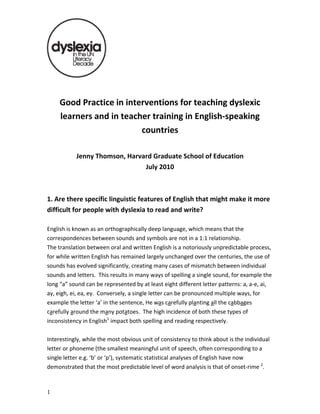
English by Professor Jenny Thompson: Report
- 7. Phonics program resources International Dyslexia Association: http://www.interdys.org/InsInt.htm Offers a matrix comparing multisensory reading programs Florida Center for Reading Research (FCRR): www.fcrr.org Provides reports of reading programs and their research‐base What Works Clearinghouse: www.ies.ed.gov/ncee/wwe Collects and reviews empirical research on educational products The Center on Instruction: www.centeroninstruction.org A US site providing resources including research reports on educational products for reading, math, science, special education, and English language learning Best Evidence Encyclopedia: www.bestevidence.org Created by the Johns Hopkins University School of Education’s Center for Data‐Driven Reform in Education, USA Canadian Language and Literacy Network: http://www.cllrnet.ca/ 7
- 8. b) Process Key features of best practice for teaching process: 1. Phonetic 2. Multisensory 3. Cumulative & Sequential 4. Small, Scaffolded Steps 5. Insure Automatization Through Practice and Review 6. Provide Mental Modeling 7. Provide Opportunities for Success Perhaps the best way to elaborate on the optimal teaching process is to examine the practices of successful specialist schools for individuals with dyslexia. Many such schools exist across English‐speaking countries and the Benchmark school is highlighted here, Pennsylvania, U.S.A, largely due to the very explicit ways its practice has been outlined in a published article, including details about the school organization, admissions policy, staffing, environment, curricula and ethos. The article6 can be downloaded here: http://www.msularc.org/docu/benchmark.pdf 6. Teacher Knowledge The importance of teacher knowledge was something that came out clearly from the questionnaires as an area of need. Across English‐speaking countries, classroom teachers reported feeling unconfident about how to detect a child at risk of dyslexia and varying accessibility to specialist support. A useful resource to emerge this year comes from the Rose report5 , published in the UK. In terms of teacher knowledge the report advocates for a 3 tier system, as summarized below. 8
- 10. whom the experience of learning may have contained more effort and/or disappointment than their typically‐reading peers. Factors commonly identified as conducive to learning were: • Ensuring success. Creating achievable, mutually‐agreed upon learning goals to create a positive sense of self‐efficacy, which in turns increases the amount of future effort a student is willing to expend in literacy‐ related tasks. • Increasing motivation through literacy materials/activities that connect to a student’s interests or functional needs. • Teacher beliefs. Both teachers and students reported the learning potential engendered when a teacher believes and demonstrates a certainty that progress is possible, and celebrates progress as it occurs. • Teacher validation of student learning style. By accepting the current student’s way of learning a climate of trust is established that helps facilitate positive change. • Explicit modeling of successful learning strategies. Many practitioners reported that modeling for a student the strategies and processes involved in achieving their next learning goal allowed students to gradually internalize these steps, growing as independent learners in the process. • Positive learning environments • Timely feedback 7. Dyslexia and Inter‐Agency Collaboration Across countries, cross‐agency collaboration around dyslexia appears to be inconsistent, unless legally required in order to meet the needs of specific students, where such laws are in place (e.g. USA and UK). 10
- 12. Summary • Intensive, multi‐sensory systematic phonics instruction should be at the heart of dyslexia intervention • Early identification is critical, and teacher preparation should facilitate this • Dyslexia can have serious effects on an individual’s wider academic, social and emotional development: attainable goals and expectation of success are key References 1. Ziegler, J.C., Stone, G.O. & Jacobs, A.M. What is the pronunciation for ‐ough and the spelling for /u/? A database for computing feedforward and feedback consistency in English. Behavior Research Methods, Instruments & Computers 29, 600‐618 (1997). 2. Treiman, R., Mullennix, J., Bijeljac‐Babic, R. & Richmond‐Welty, E.D. The special role of rimes in the description, use, and acquisition of English orthography. Journal of Experimental Psychology: General 124, 107‐136 (1995). 3. OECD. Equally prepared for life? How 15‐year‐old boys and girls perform in school. (OECD, Paris, 2009). 4. NICHD. Report of the National Reading Panel. Teaching children to read: An evidence‐ based assessment of the scientific research literature on reading and its implications for reading instruction: Reports of the sub‐groups. (U.S. Government Printing Office, Washington, DC, 2000). 5. Rose, J. Identifying and teaching children and young people with dyslexia and literacy difficulties. (Department for Children, Schools and Families London, UK, 2009). 6. Pressley, M., Gaskins, I.W., Solic, K. & Collins, S. A Portrait of Benchmark School: How a School Produces High Achievement in Students who Previously Failed. Journal of educational psychology 98, 282 (2006). 12
